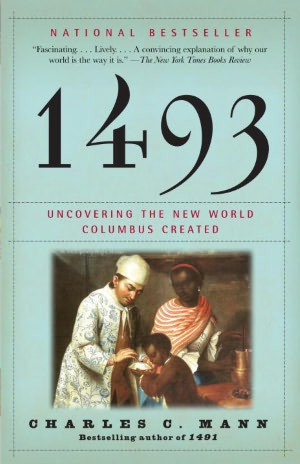In 1493: Uncovering the New World Columbus Created, author Charles C. Mann devotes a chapter to the flow of silver from the Americas to Europe and Asia. It is an interesting story, and one that I only knew part of before reading his treatment.
"As rich as Potosi" was for many years a common saying. A huge silver deposit was found there (and mercury deposits close by that could be used to refine the silver ore). A city grew up around the mines, located at 13,000 feet elevation. Mann describes the exploitation of the Indians to mine and refine the silver, and the heavy toll in sickness, injury and death that they suffered in the process. He does not mention that silver deposits in Mexico that were similarly exploited, nor the gold that was taken from the Americas. (Remember the room full of gold vessels and ornaments that was used to ransom Atahualpa, the Inca, and melted to make ingots to ship to Spain.)
The gold and silver that flooded into Spain allowed the Spanish royal government to hire soldiers and to conduct wars of conquest in Europe, not to mention to fund the conquest and exploitation of the Americas.
Mann points out that a large portion of the Spanish silver from the Americas wound up in Asia. Some passed to Asia from Europe, but there was a large scale traffic in Spanish ships that traveled from Mexico to the Philippines, where there was a large scale trade with Chinese merchants. Chinese silk clothing purchased in the Philippines with silver from Potosi was sold in Spain for less than comparable products of Spanish manufacture; the silver from South America was shipped to Asia via Mexico, and the Chinese trade goods were shipped to Europe again via Mexico.
There is a hidden story there. The relative values of silver and silk were different in China, the Philippines and Spain. Silver sent from Potosi was used to buy silk from China that had been bought with silver from Potosi -- and the cost of shipping the silk across two oceans was less that the difference in prices of silk in silver in Spain and China.
Ultimately, the flood of silver (and gold) into China and into Spain resulted in inflation. Silver coins were available in such numbers that more and more were needed to pay for the same products. In both cases, governments taxed in fixed amounts of silver, and consequently saw the value of their tax income decline. In both cases, they failed to adjust their expenditures and went broke.
I am tempted to believe that the foolish monetary policies of the Spanish and Chinese kings were the results of lack of economic knowledge. On the other hand, the United States has over the past thirty years seen a huge debt accumulated by a government that continued to spend more than it took in in tax income. Our economists know a lot more now about monetary and fiscal policy than did anyone did centuries ago. Apparently many of our politicians don't listen to the economists.
Previous posts related to 1493:

1 comment:
The Washington Post published an article last week on the mine at Potosi. Once Cerro Rico produced prodigious amounts of silver for the Spanish empire; today it produces lead and zinc. The miners continue to die young as they did in the past. The mountain is not so riddled by the mine works that it is in danger of collapsing. Click here for more.
Post a Comment